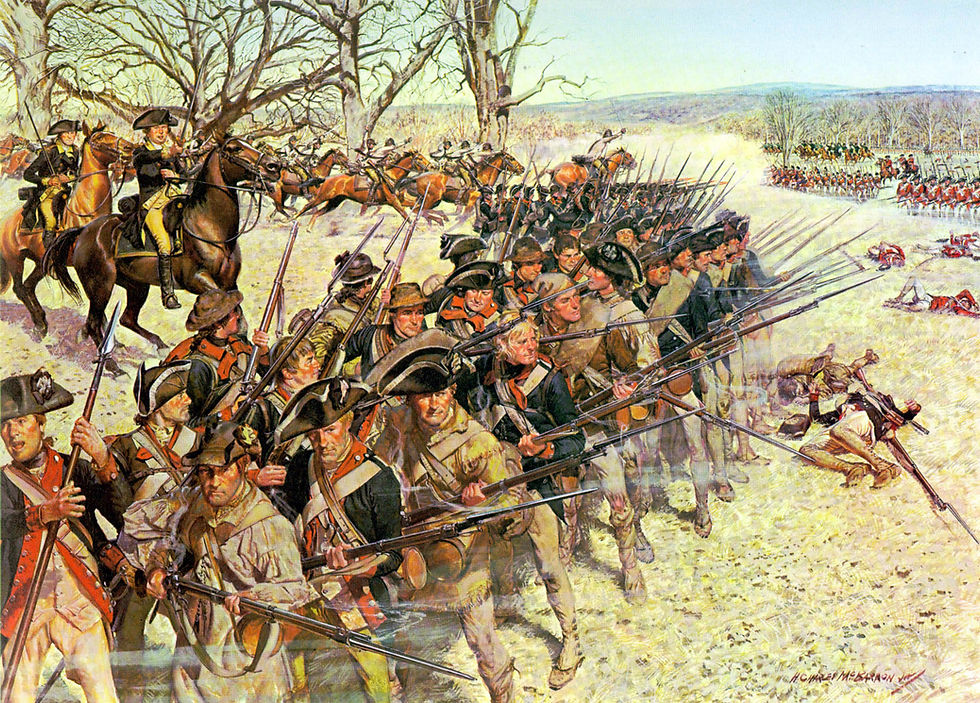This Day in History: The Battle of Guilford Courthouse
- tara
- Mar 15, 2021
- 3 min read
Updated: May 3, 2024
On this day in 1781, the Battle of Guilford Courthouse takes place. It was technically a British victory—but only technically. Indeed, one member of Parliament later noted: “Another such victory would ruin the British army.”

The British had become frustrated with the status of the war in the North, and they decided to turn to the South. They hoped to win and build a base there, then use it to crush the North. The strategy worked at first. Savannah fell in late 1778, as did Charleston in 1780. In August 1780, Americans suffered another devastating loss at the Battle of Camden. This final loss prompted the replacement of Horatio Gates, who had been commanding American forces in the South. Washington’s choice, Nathanael Greene, finally took over.
Greene arrived in late 1780, just before Daniel Morgan’s stunning victory at the Battle of Cowpens. Naturally, British General Charles Cornwallis would not let such a victory go unanswered. Greene thus moved to consolidate his troops with Morgan’s and to gain reinforcements. The weeks that followed have been called the “Race to the Dan.”
In short, Greene’s troops were trying to get to Virginia and to reinforcements. Cornwallis was trying to catch them. Greene won the race to Virginia, but he gained another important objective as well: Cornwallis’s pursuit had separated him from his base of supplies. Cornwallis realized his vulnerability and turned back. By then, Greene was ready to engage.
Greene chose a spot back in North Carolina near the Guilford Courthouse. He arrived on March 14 and set up camp; he intended to attack the British the next morning.
It didn’t quite work out that way. Greene later reported to Governor Thomas Jefferson that the British “anticipated our designs and moved down upon us. We were in perfect readiness to receive them.” Greene had dispatched William Washington and “Light Horse Harry” Lee to guard two possible roads to the Guilford Courthouse. For his part, Cornwallis had ordered British soldiers to leave camp at 5:30 a.m., and he had dispatched Bloody Banastre Tarleton to move ahead of the main army.
Tarleton’s advance guard clashed with Lee on one road to the courthouse. Lee was successful in inflicting damage, then returned to report the skirmish to Greene. In the meantime, Greene had his defenders arranged in three lines of defense at the courthouse, and Americans were ready when the British finally arrived. The British forced their way through the first two lines of Americans, taking significant casualties during the process. The third line of Americans were Continentals. They were not as experienced as the British, but they were rested and better trained than militia. This group fought hard! Of the battle, Cornwallis later observed that “I never saw such fighting since God made me. The Americans fought like demons.”
The fighting ended when Cornwallis decided to fire two cannons straight into the fighting, even though it would mean taking down some of his own men. The Americans withdrew, leaving the field to the British. The British had technically won. But Greene had inflicted a great deal of damage. As he told the North Carolina Governor: “The Enemy loss is very great, much more than ours. . . . Their operating force is diminished in such a manner, that I am not without hope of turning their victory into defeat.”
Which is exactly what happened several months later when Cornwallis surrendered at Yorktown.
Primary Sources:
Hugh F. Rankin, The North Carolina Continentals (1971)
Henry Lumpkin, From Savannah to Yorktown (1981)
John Buchanan, The Road to Guilford Courthouse: The American Revolution in the Carolinas (1999)
Letter to Thomas Jefferson from Nathanael Greene (March 16, 1781)
Letter to George Washington from Nathanael Greene (March 18, 1781)
Michael Cecere, Race to the Dan: "Pushed with Great Expedition" (Journal of the American Revolution; Feb. 18, 2014)



Comments